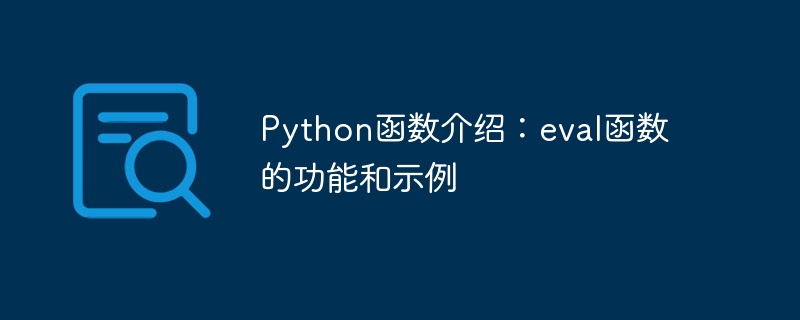

Introduction to Python functions: functions and examples of the eval function
In Python programming, the eval function is a very useful function. The eval function can execute a string as program code, and its function is very powerful. In this article, we will introduce the detailed functions of the eval function, as well as some usage examples.
1. Function of eval function
The function of eval function is very simple. It can execute a string as Python code. This means that we can execute the content representing the program code in a string and obtain the execution results.
2. Usage of eval function
The usage of eval function is very simple. It accepts a string type parameter, which can be any legal Python code. We can use the eval function to return the result of code execution.
The following is a simple example:
result = eval("1 + 2")
print(result)In this example, we use the eval function to perform a simple addition operation. Here, we are passing a string "1 2" as parameter to the eval function. When the eval function executes, it treats the string as a Python expression and returns the value of the expression, which is 3.
In addition, the eval function can also be used to execute complex Python program code. We can use the eval function to create functions, classes, or other Python objects. The following is a more complex example:
code = """
def calculate(x, y):
result = x ** y
return result
"""
exec(code)
result = eval("calculate(2, 3)")
print(result)In this example, we first initialize a string type variable code, which contains the definition of a Python function calculate. Next, we use the Python built-in function exec to execute the code string as program code, thereby defining a new function calculate in the current scope. We then use the eval function to execute the string "calculate(2, 3)", which represents a call to the calculate function. Finally, we print out the return value of the calculate function and get the result 8.
In addition to executing Python code, we can also use the eval function to convert strings into Python objects. For example, we can convert a string to a Python list, tuple, dictionary, etc.
The following is an example of converting a string into a Python list:
str_list = "[1, 2, 3, 4, 5]" my_list = eval(str_list) print(my_list)
In this example, we first define a string variable str_list, which contains the definition of a Python list. We then use the eval function to convert this string into a real Python list and print it out.
3. Precautions for the eval function
Although the eval function is very useful, there are also some things that need attention. First, we need to avoid using the eval function to perform untrusted user input. Since the eval function can execute arbitrary Python code, its misuse may lead to code injection attacks.
Secondly, we need to avoid using the eval function frequently in loops. Since the execution of the eval function requires the interpreter to parse and compile the string, its execution efficiency is low. If we use the eval function frequently in a loop, it may cause the program to run slower.
4. Conclusion
The eval function is a very powerful Python function that can execute a string as Python code. Although the use of the eval function needs to follow some safety and efficiency principles, it can be very useful under the right circumstances.
The above is the detailed content of Introduction to Python functions: functions and examples of eval function. For more information, please follow other related articles on the PHP Chinese website!




